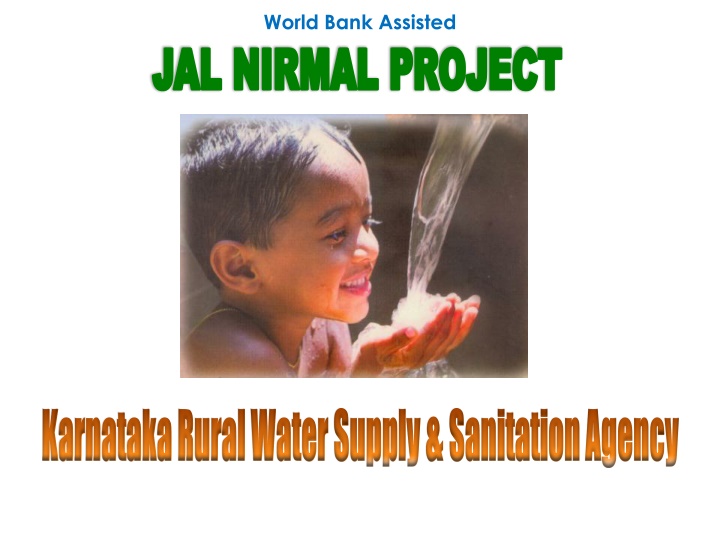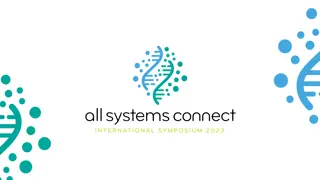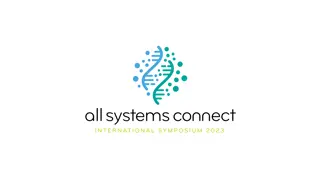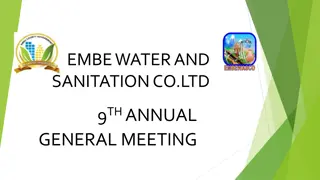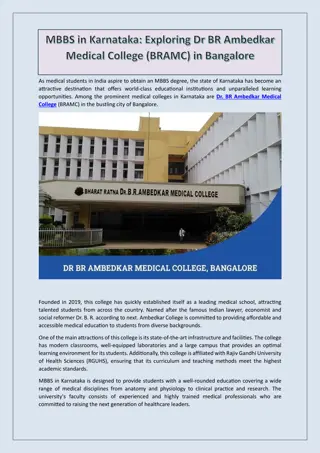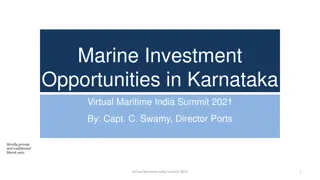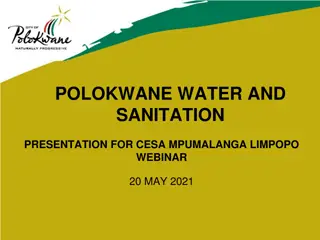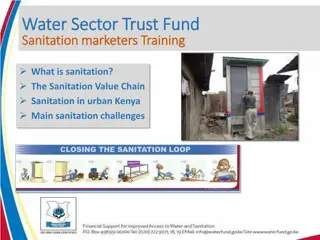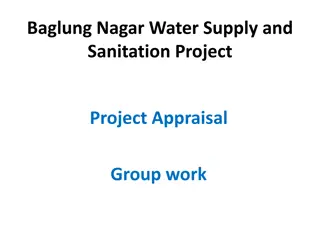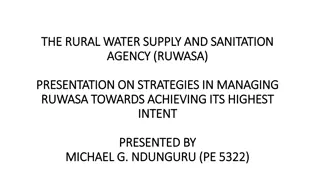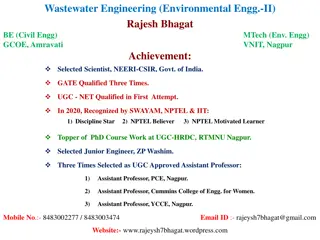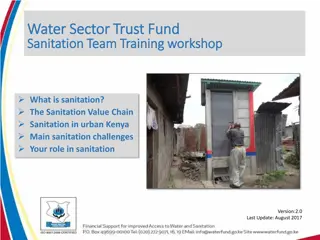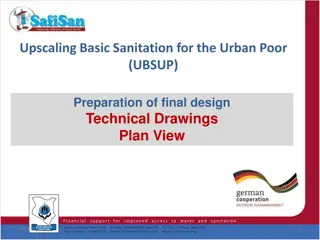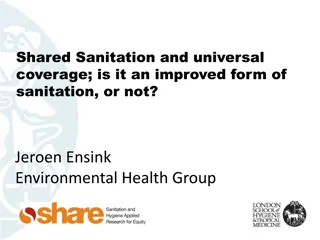Karnataka Rural Water Supply & Sanitation Project Overview
The Karnataka Rural Water Supply & Sanitation Project, assisted by the World Bank, focuses on enhancing water supply, sanitation facilities, and community empowerment in rural areas. The project involves components like water quality tests, household toilets, and women empowerment activities. Through strategies like PRA activities, scheme planning, and VWSC formation, the project aims to improve water and sanitation infrastructure while engaging the local community. Roles and responsibilities of VWSC/JC members include managing project operations, maintenance, and community contributions.
Download Presentation

Please find below an Image/Link to download the presentation.
The content on the website is provided AS IS for your information and personal use only. It may not be sold, licensed, or shared on other websites without obtaining consent from the author.If you encounter any issues during the download, it is possible that the publisher has removed the file from their server.
You are allowed to download the files provided on this website for personal or commercial use, subject to the condition that they are used lawfully. All files are the property of their respective owners.
The content on the website is provided AS IS for your information and personal use only. It may not be sold, licensed, or shared on other websites without obtaining consent from the author.
E N D
Presentation Transcript
World Bank Assisted JAL NIRMAL PROJECT JAL NIRMAL PROJECT Karnataka Rural Water Supply & Sanitation Agency Karnataka Rural Water Supply & Sanitation Agency
Government of Karnataka has set up Karnataka Rural Water Supply & Sanitation Agency (KRWS&SA) at State & District Support Unit at District Level as Nodal Agency with the Support of Zilla Panchayat Department for Project Planning. Procurement & Construction. Operation & Maintenance. Management of Rural Water Supply & Sanitation Facilities.
PROJECT COMPONENTS Water Supply Recharge Measures Water Quality Tests Internal Road & Drains Household Toilets Smokeless Chullas School Sanitation GP Strengthening Women Empowerment
Strategy for conducting the PRA Activities: Drawing the Village Map. Social Map. Weather Map. Economic Status. Group Discussion. Draft Project Report.
Planning Process of the scheme , Conceptual plan for the village in association with community. Preparation of Preliminary Scheme report & deliberation of the same in Gram Sabha & Conclusion of agree to participate (ATP) Agreement. Carrying out detailed survey/ leveling & collection of technical data & proposal of development of additional source, based on this Preparation of detailed project report (DPR) including designing, cost estimate & time schedule. Deliberation of detailed project report in Gram sabha & Conclusion of agree to do (ATD) Agreement. Motivating the community for contribution of 10% of the project cost by community development specialists of support agency & DSU. On receipt of 50% contribution tender documents to be prepared & processed.
VWSC Formation As per Karnataka Panchayat Raj Act of 1993 section 61 A, Village Water Supply & Sanitation Committee (VWSSC) is formed through Gram Sabha as a sub- committee of Gram Panchayat. Members of VWSC include both elected & selected representatives from the village. VWSC will have 33% Women & 18% SC/ST.
Roles & Responsibilities of VWSC/JC Members Collection of Community Contribution. Conducted the VWSC/JC Meetings. Involvement in Project Planning, Implementation , Post implementation Phase. Contractor Bill Payment. Manage the Effective Operation & Maintenance.
Joint Committee (JC) Formation for Multi Village Scheme Joint committee is formed as per section 79 of Karnataka Panchayat Raj Act 1993 for efficient implementation & management of Multi Village Scheme. It has representation from the concerned VWSCs/GP. Joint Committee(JC) Operations & Maintenance Right from the beginning the committee members followed the practice of adhering to the resolutions passed at the meetings. In the initial period, the Joint committee meet once a week and subsequently once a month. The amount of water tax collected from the respective Gram Panchayat is calculated in each meeting. Apart from the president and members of the Joint Committee, the elders too participated in the meetings of the joint committee. Their suggestions provide useful inputs for the operations and management of the project. A bank account of the Joint committee is opened. Remuneration for the project staff is paid from the operations and Management account.
Sustainability Monitoring Exercise (SME) implementation results on the ground and intended impacts in terms of technical, financial & Institutional sustainability of schemes. SME was taken up initially in the World Bank Assisted 1st Project (1993-2000) in Karnataka which later continued through the 2nd Project (2002-2009) as a key participatory tool to measure project performance in the state. Encouraging from the early SME results, this exercise has been continued under Additional Financing Project villages also as an in-built learning process to further enhance accessibility, reliability, equitability & Sustainability if investments in water & sanitation sector in the state. SME is participatory tool to measure
Methodology for SME SME is conducted through a multi disciplinary team comprising Engineer, social development specialists, finance persons, NGO/consultants, representatives of VWSC/GP/JC, village leaders (Men & Women) representatives of PRIs etc. Each SME will be of one day duration covering water supply hours of both morning and evening. Besides, collecting information about the schemes using structured questionnaires, the exercise also focuses on monitoring and analyzing of System functioning. User s perceptions. Operation, Maintenance & Management Organization & Governance For the sustainability assessment result of the completed schemes representing in terms of highly likely sustainable, likely sustainable, uncertain and unlikely sustainable.
Measurement of Scheme Sustainability Project had adopted Sustainability Monitoring Exercise (SME) which was a Participatory Tool to measure sustainability of all the completed schemes from Technical, Institutional & Financial angles. 1st round SME conducted in-house and subsequent rounds through external consultant on sample basis. SME was carried out through a multi disciplinary team representing Project Stakeholders focusing on :- Functioning of VWSC System Functioning User s perception O & M
SME Results Schemes Nos 2460 SME Year 1st round SME (In-House) From 2008 2nd round SME (External Consultant) 2009 300 3rd round SME (External Consultant) 2010 300 Rating 2nd Round 51% 40% 8% 1% SME Out Come 1st Round 56% 35% 7% 2% 3rd Round 70% 27% 2% 1% Highly Likely Likely Uncertain Unlikely Average of 93 % schemes fall under likely to highly likely sustainable categories
Operation & Maintenance Budget Scheme wise preparation of Operation & Maintenance Budget. Scheme Maintenance Expenditure meet through tariff. Each house hold, community paid the water tariff monthly.
Capacity Building And Sanitation Conducting VWSC orientation meetings/ Trainings. Conducting JC Orientation meeting/ Trainings. Conducting PRA for all project villages. Conducting ATP,ATD & ATI Programme. Conducting GP Members orientation meetings/ Training & SHG s Mela. Conducting Procurement Trainings. Ward/ Street Meetings, HHL, SLC awareness Programme. Education for Sanitation (HHL, SLC, Drainage, Garbage, Washing Plat form, Cattle trough etc.)
O&M O&M collection & management Incentivization of water tariff collection. Computerization of water tariff collection & issue of computerized receipts. VWSC puts notice board in the village regarding timing of water supply & disruptions of services if any. Process initiated for disconnection of defunct bore wells resulting in reduction of power charges. Women in development: decision making, bill collector, water quality testing person, Promotion of Sanitation facilities & Smokeless Chullas
Case study of Belawadi Village in Belgaum District Description of the water supply scheme costing 112.52 lakhs The scheme has very vital features they are Mobilisation of resource 85 % of fund available from project 10 % of fund mobilized by users community ( It was collected from all the house holds of the village) 5 % of fund mobilized by concerned GPs from their income. Gram Panchayat has taken responsibility of scheme implementation. In W2 document, Technical support given by PRED & ZP-DSU from bottom level to top level it implement through Gram Panchayat so far maintain by them only. ii) People s active participation and their involvement is major role to achieve the goal and seek the project. iii) There is no political interpenetration in development works all are co operate very well therefore these villages water supply and sanitation project has been success. i) Decentralize the powers implementation mechanism is to implement
Evidence of Performance: 1) Before initiate the tender 100% Community Contribution was made 2) 6.5 lakh Community Contribution was made before invite the tender 3) Out of 1565 HH all have contributed except EWS contribution has made by community before intervention of Tender. 4) VWS Committee has collected the Beneficiary contribution them selves voluntarily with out any pressure. Total Population : 8061 Total House holds : 1565 Total House connections: 1327 Total Non House connections HH : 238 Annual O&M Budget : Rs,7.92 lakh Water tariff for HC : 50.00 ( Up to 10,000 ltrs above this Rs. 8/- per 1000 ltrs ) Water tariff for Non HC : 30.00
BELAWADI VILLAGE PHOTOS Water meter Pump House & Pure Water Sump Balancing Tank Slow sand filter
